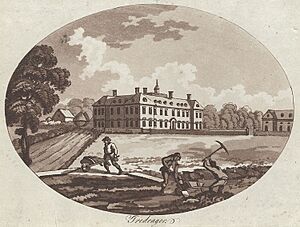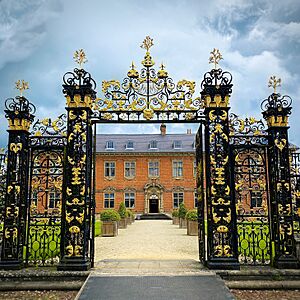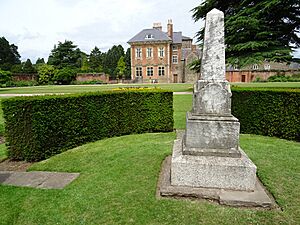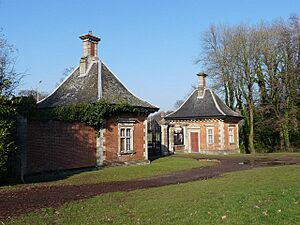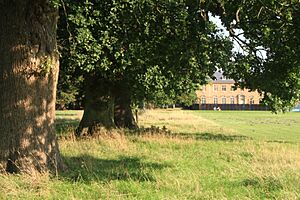Tredegar House facts for kids
Quick facts for kids Tredegar House |
|
|---|---|
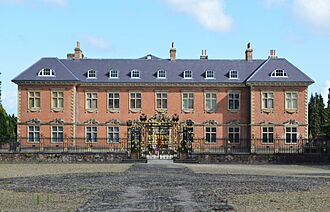
"The most splendid brick house of the 17th century in Wales."
|
|
| General information | |
| Type | Country house and gardens (32 hectares) |
| Architectural style | Carolean |
| Town or city | Newport, Monmouthshire |
| Country | Wales |
| Coordinates | 51°33′41.66″N 3°1′45″W / 51.5615722°N 3.02917°W |
| Construction started | 1664 |
| Completed | 1672 |
| Client | William Morgan (of Machen and Tredegar) |
| Management | National Trust |
|
Listed Building – Grade I
|
|
| Official name | Tredegar House |
| Designated | 3 March 1952 |
| Reference no. | 2902 |
| Official name | Tredegar Park |
| Designated | 1 February 2022 |
| Reference no. | PGW(Gt)48(NPT) |
| Listing | Grade II* |
Tredegar House (in Welsh: Tŷ Tredegar) is a large, beautiful house from the 1600s. It is located in Coedkernew, near Newport, Wales. For over 500 years, this amazing mansion was the home of the powerful Morgan family. They were very important people in the area.
Experts have called Tredegar House "the most splendid brick house of the 17th century in Wales." It is also known as one of the best houses from the time of King Charles II in all of Britain. The house sits in a lovely park that is about 90 acres (0.36 square kilometers) in size. Tredegar House became a special Grade I listed building in 1952. Since 2012, the National Trust has taken care of it. The park around the house is also very important, listed as Grade II*.
Contents
What Does Tredegar Mean?
The name Tredegar first appeared in the 1300s. It was spelled Tredegyr back then. This name likely comes from two Welsh words: tre(f) meaning 'a farmstead' and the name Tegyr. The name Tegyr might mean 'fair king'.
Later, in the 1500s, the spelling changed to Tredeger and other similar forms. Over time, Tredegar became the most common spelling. This name was also used for the Tredegar Iron Company in 1800. That company then gave its name to the town of Tredegar.
Today, the Welsh name for the house is 'Tŷ Tredegar'. This simply means 'Tredegar House' in Welsh.
A Look at History
The oldest part of Tredegar House was built in the late 1400s. The house was first made of stone. It was important enough to host King Charles I in 1645.
Between 1664 and 1672, a man named William Morgan decided to rebuild the house. He made it much bigger and used red brick. Red brick was a very rare building material in Wales at that time. We don't know for sure who designed the new house. However, some historians think it might have been Roger and William Hurlbutt. They built other grand houses like Ragley Hall.
An expert on Welsh houses, Peter Smith, said Tredegar was "the most splendid brick house of the seventeenth century in Wales." In 1882, Octavius Morgan, a local historian, shared a drawing of a fancy garden maze. This maze was at the house before the 1660s changes. It was probably from the time of Queen Elizabeth I.
The Morgan Family of Tredegar
The Morgan family lived at Tredegar House for over 500 years. The house was the main home for the old Morgan family. They were descendants of a person called Cadifor the Great. The first record of a Morgan living at Tredegar is from 1402.
When Henry Tudor became King Henry VII, it was good news for the Morgans. They had supported Henry. Sir John Morgan was rewarded for his help. In 1485, the new king made him 'Sheriff of Wentloog and Newport'. He also became 'Steward' of the Machen area. This made Sir John Morgan very powerful. Around 1490, he started building a new house at Tredegar. A part of Sir John's stone manor house still stands today. It is the oldest part of the current Tredegar House.
Some members of the Morgan family, who were related to Sir Thomas Morgan, became important figures. Three brothers, Thomas, Robert, and Edward, were part of this group. Thomas became Major-General Sir Thomas Morgan, 1st Baronet. He fought for the Parliament during the English Civil War (1642–1649). He became Governor of Gloucester in 1645. He later fought in Flanders and was injured. In 1661, he retired to his home in Herefordshire. He was called back in 1665 to be Governor of Jersey. He passed away in 1679. His eldest son, Sir John Morgan, also became a soldier.
Robert Morgan became a farmer. He was the father of Henry Morgan, who became a famous privateer in the Caribbean. A privateer was like a pirate, but they had permission from their government to attack enemy ships. Edward Morgan became Colonel Edward Morgan. He fought for the King during the English Civil War. After the King was arrested, he went to Europe. He married Anna Petronilla from Germany. They had six children. He was also the Lieutenant Governor of Jamaica from 1664 to 1665.
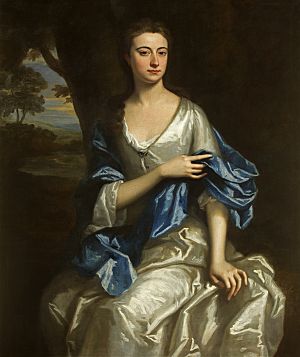
During the Civil War, King Charles I visited Tredegar House in 1645. In 1661, William Morgan rebuilt the house to be very grand. He used a large amount of money that came from his wife, Blanche Morgan. The family's wealth continued to grow over the years. This was greatly helped by the smart business ideas of Sir Charles Morgan, 1st Baronet in the 1700s.
His son, Sir Charles Morgan, 2nd Baronet, continued to expand many business and industrial projects. He helped make Newport an important trading city. The family became very influential in politics and business. They were given the title of Baronet in 1792 and Baron in 1859.
In 1854, Godfrey Morgan fought in a famous battle called the Charge of the Light Brigade. He was 22 years old and a Captain. His horse, Sir Briggs, also survived the battle. Sir Briggs lived at Tredegar House until he was 28. The horse was buried in the Cedar Garden, and a special memorial was built over its grave. In 1905, Godfrey became the first Viscount Tredegar. He never married, so when he passed away, the estate went to his nephew, Courtenay Morgan. In 1920, the Tredegar Park Polo Club was started at Tredegar House.
Over the next two generations, the family faced financial challenges due to their spending and taxes. John Morgan, 6th Baron Tredegar passed away in 1962 without children. His death marked the end of the Morgan family living at Tredegar. In 1951, Tredegar House was emptied, and its contents were sold. The estate was also sold.
Who Owns Tredegar House Now?
After the Morgan family sold it, Tredegar House was bought by the Catholic Church. It was used as a school for girls, run by the Sisters of St Joseph. John Morgan, who had recently become Catholic, said the sale was "good for his bank balance, and his soul."
In 1974, Newport Borough Council bought the house. Because of this, some people jokingly called it "the grandest council house in Britain."
In 2012, the National Trust took over running the house and its 90 acres of grounds. They have a 50-year lease from Newport City Council. The National Trust said Tredegar House is very important. Many similar old properties have been lost over the last 100 years. The National Trust allows visitors to explore most of the house.
Filming and Fun Events
Tredegar House has been used as a location for many TV shows and movies. In 2014, an episode of the Antiques Roadshow was filmed there. The house's red brick outside is now even shown in the show's opening.
Other TV series like Being Human, Da Vinci's Demons, and The Hairy Bikers have also used the house for filming.
Since the show returned in 2005, many episodes of Doctor Who have been filmed at Tredegar House. These include "The Christmas Invasion" (2005), "New Earth" (2006), "The Impossible Astronaut" (2011), "The Woman Who Lived" (2015), and "Spyfall, Part 2" (2020). The house was also used for the 2024 episode "Rogue".
The house hosts many fun events throughout the year. These include an Easter Egg Hunt, Pirate's Day, and a 1930s Garden Party in August. They also have special events for Halloween and Christmas. The Christmas event is often based on Charles Dickens's A Christmas Carol. Visitors can also enjoy daily talks, activities, and special tours. An annual Folk Festival takes place in May.
Tredegar House is a popular place for weddings and other private parties.
For many years, a yearly vintage car rally was held in the grounds. This event helped raise money for Leukaemia Research. The first rally was in 1980 and raised £635. The last rally was in 2014 and raised £80,000. In total, the rallies raised £868,000 for charity.
More to Explore
- Ruperra Castle
- Tredegar Square, London E3
- Baron Tredegar
See also
 In Spanish: Tredegar House para niños
In Spanish: Tredegar House para niños


